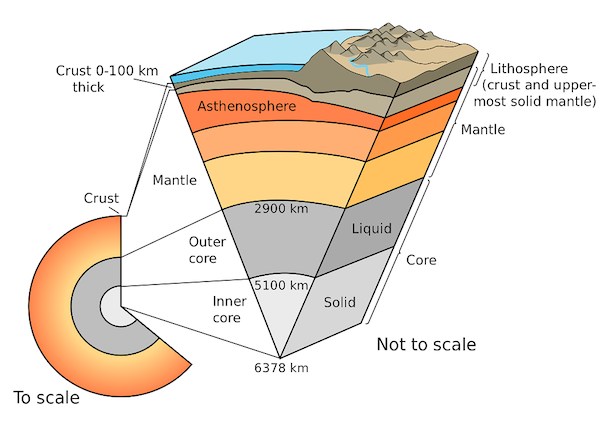It's a simple question.. What do continents "lay" on? Do they float on water? or are they huge bodies that "emerge" from the sea floor/bed? are they connected to the bottom of the oceans? Hope the question is clear. Don't be afraid to be thorough and scientific in your answer, I'll appreciate it and do everything to understand it.
3 Answers
Matan, the continents where we all live "float" on the Earth's mantle. The continents are made out of relatively brittle rock called the "Crust" and the mantle is made out of much more ductile material. The mantle, however, is NOT liquid. It is just much more ductile than the crust so, in geologic time, it can flow (like silly putty). Also, the mantle is much more dense, so the crust doesn't sink into it by gravitational/bouyancy forces alone.
Think of it as a creme brulee. We live on the little hard crust on the top. And there just happens to be a little bit of water on that crust that covers the less-elevated parts.
Now, a little more technical, the crust that makes up the continents and the crust that is under the deep oceans are actually compositionally different. This is because the magma that solidifies to form each of these crusts travels, by partially melting its way up, through different materials and different thicknesses. The consequence of this is that the crust making up the continents is less dense than that making up the bottom of the oceans.
The image above shows the process by which we get new (left) oceanic crust, (right) continental crust, and (middle) a special type of crust like that in Hawaii. Note that when two tectonic plates collide, the more dense one will tend to subduct under the other.
-
1$\begingroup$ Wow.. Amazing, simply amazing. Astonishing answer! It's must clearer for me now, thanks a lot! $\endgroup$– MatanCommented Apr 24, 2016 at 10:35
-
$\begingroup$ No problem! Earth Science is pretty cool! $\endgroup$– AntonioCommented Apr 25, 2016 at 0:29
-
2$\begingroup$ You missed out the Cratons, Cratons are the really light, deep, and very old pieces of Continental Crust that have survived since the Precambrian and are really important in defining the tectonic plates we have today, otherwise this is a perfect answer. $\endgroup$– AshCommented Aug 15, 2017 at 14:20
There is no ocean of magma, magma only forms below when rocks have been melted due to various causes like flux melting and heat decompression, the only part of the earth that is liquid is the outer core and it is of uniform composition.
[This answer has been highly critisized for using only the oversimplified descriptions used in school textbooks as an answer; the original answer is included only to make sense of the comments]
(I'm not a professional geologist; this is from my personal studies) Lava, essentially. The Earth is molten when you get farther down, and the surface of the planet is made up of large plates of stone, which very slowly get pushed around by huge swirls of lava beneath them.
Note that this is a very simplified explanation, but it seems to answer your question.
-
6$\begingroup$ Incorrect. The overwhelming majority of the stuff that's under the continents is solid rock, not molten lava/magma. $\endgroup$– GimelistCommented Apr 24, 2016 at 4:15
-
3$\begingroup$ The prevalent existence of deep magma is one of the biggest misconceptions about the structure of the Earth. It is overwhelmingly solid and any amount of magma is insignificant. It would be best if you teach it correctly to your 7th graders because otherwise the misconception will linger around. I repeat: There is no concentration of magma that the continents lay on. This is a scientific fact, regardless of whether you think it is true or not. $\endgroup$– GimelistCommented Apr 24, 2016 at 21:49
-
5$\begingroup$ But this is not molten rock. This is my point. It is as solid as any rock you would pick up at the surface of the Earth. And to a 7th grader, saying that it is molten rock is incorrect and perpetuates the misconception that there is a magma ocean underneath the crust. Anyway, if you want we can continue this discussion in the chat, or you can open another question: "is there a magma ocean in the Earth?". $\endgroup$– GimelistCommented Apr 25, 2016 at 0:30
-
3$\begingroup$ There are no large bodies of magma in the mantle. We know this because we can measure the propagation of seismic shear waves through the mantle and they propagate through the whole mantle, meaning that it must be solid, because shear waves cannot travel through a liquid. S waves do not propagate through the outer core and this is how we know that it is liquid. $\endgroup$– bonCommented Apr 25, 2016 at 9:17
-
3$\begingroup$ Super hot viscous rock is not like magma to 7 graders. There is a huge difference between the two: one doesn't erupt in volcanoes whereas the second does. You can compare the two to chocolate slightly warned by hands that becomes soft and bends, but is still solid. Magma, on the other hands, is like chocolate on a fountain. 7th graders like chocolate! You can even make a nice demonstration in class. $\endgroup$– GimelistCommented Apr 25, 2016 at 20:34

